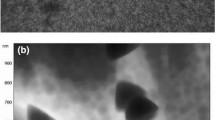Abstract
A new field emission theory of dislocation-sensitized photo-stimulated exo-electron emission (DSPEE) is proposed, which shows that the increase in the intensity of photo emission fromF-centres during plastic deformation is caused by the appearance of an electric field which draws excited electrons out of the deeper layer and, therefore, increases the number of electrons which reach the surface. The theory of DSPEE shows that the variation of DSPEE flux intensity should obey the following relation
. The theory of DSPEE is able to explain several experimental observations like linear increase of DSPEE intensityJ e with the strain at low deformation, occurrence of the saturation inJ e at higher deformation, temperature dependence ofJ e, linear dependence ofJ e on the electric field strength, the order of the critical strain at which saturation occurs inJ e, and the ratio of the PEE intensity of deformed and undeformed crystals. At lower values of the strain, some of the excited electrons are captured by surface traps, where the deformation generated electric field is not able to cause the exo-emission. At larger deformation (in between 2% and 3%) of the crystal, the deformation-generated electric field becomes sufficient to cause an additional exo-electron emission of the electrons trapped in surface traps, and therefore,t here appears a hump in theJ e versusε curves of the crystals.
Similar content being viewed by others
References
U V Bichevin,Trudy Inst. Fiz. Eston SSR 43, 90 (1975)
N A Tsal, I M Spitkouskii and Ya A Struck,Sov. Phys. Solid State 26, 902 (1984)
A V Poletaev and S Z Shmurak, in Synopsis of paper presented at the Xth All Union Symposium on Mechanicoemission and Mechanicochemistry of Solids,Restov/Don, p. 39 (1986)
A V Poletaev, Thesis, Inst. Solid State Phys. Akad Nauk, SSSR, Chernagoporka (1985)
A V Poletaev and S Z Shmurak,Sov. Phys. Solid State A26, 12 (1984)
M I Molotskii and S Z Shmurak,Phys. Stat. Solids A120, 83 (1990)
N F Mott and W R Gurney, Electronic processes in ionic crystal (Dover Publications Inc, New York, IInd edition, 1950) p. 172
M I Molotskii,Sov. Sci. Rev. B13, 1 (1989)
Author information
Authors and Affiliations
Rights and permissions
About this article
Cite this article
Chandra, B.P., Chandok, R.S. & Khare, P.K. Field emission theory of dislocation-sensitized photo-stimulated exo-electron emission from coloured alkali halide crystals. Pramana - J Phys 48, 1135–1143 (1997). https://doi.org/10.1007/BF02845888
Received:
Issue Date:
DOI: https://doi.org/10.1007/BF02845888



